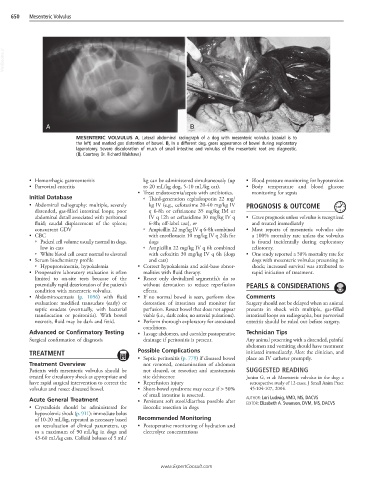Page 1289 - Cote clinical veterinary advisor dogs and cats 4th
P. 1289
650 Mesenteric Volvulus
VetBooks.ir
A B
MESENTERIC VOLVULUS A, Lateral abdominal radiograph of a dog with mesenteric volvulus (cranial is to
the left) and marked gas distention of bowel. B, In a different dog, gross appearance of bowel during exploratory
laparotomy. Severe discoloration of much of small intestine and volvulus of the mesenteric root are diagnostic.
(B, Courtesy Dr. Richard Walshaw.)
• Hemorrhagic gastroenteritis kg can be administered simultaneously (up • Blood pressure monitoring for hypotension
• Parvoviral enteritis to 20 mL/kg dog, 5-10 mL/kg cat). • Body temperature and blood glucose
• Treat endotoxemia/sepsis with antibiotics. monitoring for sepsis
Initial Database ○ Third-generation cephalosporin 22 mg/
• Abdominal radiography: multiple, severely kg IV (e.g., cefotaxime 20-40 mg/kg IV PROGNOSIS & OUTCOME
distended, gas-filled intestinal loops; poor q 6-8h or ceftriaxone 35 mg/kg IM or
abdominal detail associated with peritoneal IV q 12h or ceftazidime 30 mg/kg IV q • Grave prognosis unless volvulus is recognized
fluid; caudal displacement of the spleen; 6-8h; off-label use), or and treated immediately
concurrent GDV ○ Ampicillin 22 mg/kg IV q 6-8h combined • Most reports of mesenteric volvulus cite
• CBC with enrofloxacin 10 mg/kg IV q 24h for a 100% mortality rate unless the volvulus
○ Packed cell volume usually normal in dogs, dogs is found incidentally during exploratory
low in cats ○ Ampicillin 22 mg/kg IV q 6h combined celiotomy.
○ White blood cell count normal to elevated with cefoxitin 30 mg/kg IV q 6h (dogs • One study reported a 58% mortality rate for
• Serum biochemistry profile and cats) dogs with mesenteric volvulus presenting in
○ Hypoproteinemia, hypokalemia • Correct hypokalemia and acid-base abnor- shock; increased survival was attributed to
• Preoperative laboratory evaluation is often malities with fluid therapy. rapid initiation of treatment.
limited to on-site tests because of the • Resect only devitalized segment(s); do so
potentially rapid deterioration of the patient’s without derotation to reduce reperfusion PEARLS & CONSIDERATIONS
condition with mesenteric volvulus. effects.
• Abdominocentesis (p. 1056) with fluid • If no normal bowel is seen, perform slow Comments
evaluation: modified transudate (early) or derotation of intestines and monitor for Surgery should not be delayed when an animal
septic exudate (eventually, with bacterial perfusion. Resect bowel that does not appear presents in shock with multiple, gas-filled
translocation or peritonitis). With bowel viable (i.e., dark color, no arterial pulsations). intestinal loops on radiographs, but parvoviral
necrosis, fluid may be dark and fetid. • Perform thorough exploratory for associated enteritis should be ruled out before surgery.
conditions.
Advanced or Confirmatory Testing • Lavage abdomen, and consider postoperative Technician Tips
Surgical confirmation of diagnosis drainage if peritonitis is present. Any animal presenting with a distended, painful
abdomen and vomiting should have treatment
TREATMENT Possible Complications initiated immediately. Alert the clinician, and
• Septic peritonitis (p. 779) if diseased bowel place an IV catheter promptly.
Treatment Overview not removed, contamination of abdomen
Patients with mesenteric volvulus should be not cleared, or resection and anastomosis SUGGESTED READING
treated for circulatory shock as appropriate and site dehiscence Junius G, et al: Mesenteric volvulus in the dog: a
have rapid surgical intervention to correct the • Reperfusion injury retrospective study of 12 cases. J Small Anim Pract
volvulus and resect diseased bowel. • Short-bowel syndrome may occur if > 50% 45:104-107, 2004.
of small intestine is resected.
Acute General Treatment • Persistent soft stool/diarrhea possible after AUTHOR: Lori Ludwig, VMD, MS, DACVS
• Crystalloids should be administered for ileocolic resection in dogs EDITOR: Elizabeth A. Swanson, DVM, MS, DACVS
hypovolemic shock (p. 911): immediate bolus
of 10-20 mL/kg, repeated as necessary based Recommended Monitoring
on reevaluation of clinical parameters, up • Postoperative monitoring of hydration and
to a maximum of 90 mL/kg in dogs and electrolyte concentrations
45-60 mL/kg cats. Colloid boluses of 5 mL/
www.ExpertConsult.com

